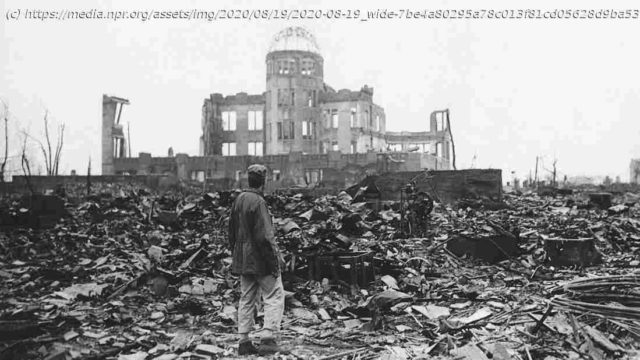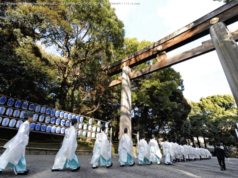When the U.S military dropped atomic bombs on the Japanese cities of Hiroshima and Nagasaki in August 1945, the American government portrayed the weapons …
When the U. S military dropped atomic bombs on the Japanese cities of Hiroshima and Nagasaki in August 1945, the American government portrayed the weapons as equivalent to large conventional bombs — and dismissed Japanese reports of radiation sickness as propaganda. Military censors restricted access to Hiroshima, but a young journalist named John Hersey managed to get there and write a devastating account of the death, destruction and radiation poisoning he encountered. Author Lesley M. Blume tells Hersey’s story in her book, Fallout: The Hiroshima Cover-up and the Reporter Who Revealed it to the World. She writes that when Hersey, who had covered the war in Europe, arrived in Hiroshima to report on the aftereffects of the bomb a year later, the city was “still just a sort of smoldering wreck.” “Hersey had seen everything from that point, from combat to concentration camps,” Blume says. “But he later said that nothing prepared him for what he saw in Hiroshima.” Hersey wrote a 30,000-word essay, telling the story of the bombing and its aftermath from the perspective of six survivors. The article, which was published in its entirety by The New Yorker, was fundamental in challenging the government’s narrative of nuclear bombs as conventional weapons. “It helped create what many experts in the nuclear fields called the ‘nuclear taboo,’ ” Blume says of Hersey’s essay. “The world did not know the truth about what nuclear warfare really looks like on the receiving end, or did not really understand the full nature of these then experimental weapons, until John Hersey got into Hiroshima and reported it to the world.” On what Americans knew about the nature of nuclear weapons in 1945 Americans didn’t know about the bomb — period — until it was detonated over Hiroshima. The Manhattan Project was cloaked in enormous secrecy, even though tens of thousands of people were working on it…. When President Harry Truman announced that America had detonated the world’s first atomic bomb over the Japanese city of Hiroshima, he was announcing not only a new weapon, but the fact that we had entered into the Atomic Age, and Americans had no idea about the nature of these then-experimental weapons — namely, that these are weapons that continue to kill long after detonation. It would take quite a bit of time and reporting to bring that out. Everybody who heard the announcement [from Truman] knew that they were dealing with something totally unprecedented, not just in the war, but in the history of human warfare. What was not stated was the fact that this bomb had radiological qualities, [that] blast survivors on the ground would die in an agonizing way for the days and the weeks and months and years that followed. On how military generals focused on physical devastation when they testified before Congress about the effects of the atomic bomb In the immediate weeks, very little [was said.] A lot of it was really painted in landscape devastation. Landscape photographs were released to newspapers showing the decimation of Hiroshima and Nagasaki. There were rubble pictures, and also obviously people are seeing the mushroom cloud photos taken from the bombers themselves or from recon missions. But in terms of the radiation — even in Truman’s announcement of the bomb — he’s painting the bombs in conventional terms. He says these bombs are the equivalent to 20,000 tons of TNT. And so Americans, they know that it’s a mega-weapon, but they don’t understand the full nature of the weapons, the radiological effects are not in any way highlighted to the American public and in the meantime, the U.
Home
United States
USA — Japan 'Fallout' Tells The Story Of The Journalist Who Exposed The 'Hiroshima Cover-Up'






